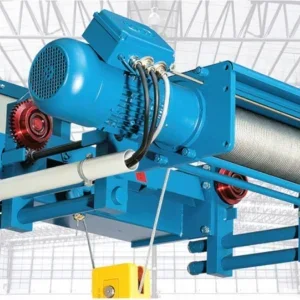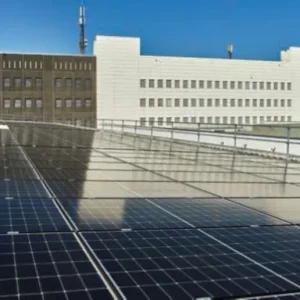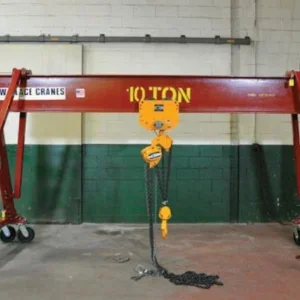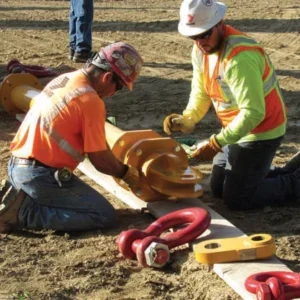Breakbulk Europe is moving to Rotterdam this month (May 17- 19), after a two-year break due to the pandemic. The event is one of the largest tradeshows for the industry, with offshore wind, oil and gas companies, carriers, ports, logistics companies, specialised freight forwarders and other service providers.
“The arrival of Breakbulk Europe is in keeping with our ambition to become Europe’s leading breakbulk port, and it will provide a great boost for the breakbulk companies in the port,” said Danny Levenswaard, director, Breakbulk, The Port of Rotterdam Authority.
In 2020, Rotterdam handled over six million tons of breakbulk. “Rotterdam is well known for its specialisation in the heavy-lift and breakbulk sector. We can handle any vessel, of any size and any type. That is why we are seen as the most versatile general breakbulk hub.”
The Port of Rotterdam facilitates 14.5 million TEU per year, welcoming 30,000 sea vessels and creating 385,000 jobs.
As the “Port of the Future”, it aims to be carbon neutral by 2050, and is embracing sustainability and digitalization. Other Dutch secondary ports are no less impressive. The Port of Amsterdam, is the largest port for chemical goods globally and has ambitions to focus on a circular economy, working with startups to reuse and recycle industrial materials more efficiently.
The Groningen Seaports consist of the port of Delfzijl, Eemshaven and the adjoining industrial sites. The Seaport hosts various clustered business sites, including a chlorine-related chemicals cluster. Eemshaven has been earmarked for the development of energy-related industry with large energy producers such as ENGIE, NorNed, Vattenfall, TenneT, and RWE, which attracted Google to set up its largest data centre of Europe here.
The Zeeland North Seaports in Zeeland is a multimodal port, with a strong focus on inland shipping, offering multimodal transport opportunities.
To cope with demand, Hutchison Ports ECT Rotterdam (ECT) recently purchased three Sany ship-to-shore container cranes, which work automatically and are remote controlled with safety functions such as anti-collision systems monitoring the movements of the crane.
“For such a huge container terminal, the size of the cranes plays a decisive role. With Super Panamax-size technical requirements, the Sany ship-to-shore container cranes fit perfectly into the concept of tasks at the ECT Delta terminal. From their high performance of the individual components to the best possible terms of delivery and the fact our European headquarters is located rather close to Rotterdam,” said Daniel Zhong, key account manager technical specialist, Sany.
Sany will be exhibiting at Breakbulk Europe this year as well as Liebherr, which recently partnered with the Port of Gdansk Eksploatacja in Poland, marking the sale of its 300th LHM 550 mobile harbour crane, which will be used for bulk handling of coke, coal and scrap metal.
The order is one of the port’s largest investments in its 30-year history, as it continues to carry out handling activities on a total area of over 89 hectares. The crane supplied has a boom length of 48 metres and a lifting capacity of up to 104 tons.
“We want to increase the effectiveness, functionality and speed of our services. The quality of our work processes will improve significantly. This will have a positive impact on our handling rate. In addition, our customers can expect faster handling of the commissioned vessels. We greatly appreciate the extraordinary mobility of this machine. We trained our crane operators at an early stage and carried out extensive modernisation measures in the port area in advance so that we could use the machine as quickly and as efficiently as possible,” said Radoslaw Stojek, chairman of the Board of Port Gdansk Eksploatacja.
The Liebherr mobile harbour crane series is suitable for a range of applications including bulk and general cargo handling, container handling and heavy-duty lifts of up to 154 tons. In addition to a hybrid drive concept consisting of diesel and electric motors, the cranes can also be used in electric only operations, making an important contribution to emission-free goods handling.
Also exhibiting at the show is Maersk Supply Service, which is building its first wind turbine installation vessel (WTIV), after winning a contract to install Empire 1 and 2 offshore wind projects in the US.
The vessel will be built in Singapore by SembCorp Marine and expected to arrive in US waters in 2025 where it will be deployed for the installation of 138 giant Vestas V236-15-megawatt turbines.
The 2 GW Empire 1 and 2 projects, developed by Empire Offshore Wind, a joint venture between Equinor and bp, are Located some 15-30 miles southeast off Long Island in New York. Once online, the facilities are expected to power more than one million homes.
“In signing this contract with Equinor and bp, we are ready to invest in Maersk Supply Service's first wind installation vessel and firmly establish Maersk Supply Service as an offshore wind contractor,” said Steen Karstensen, CEO, Maersk Supply Service.
Show exhibitor US-based Barnhart Crane + Rigging, was recently hired to recover sunken bridge sections of The Gums Crossing Bridge on County Road 21 in Yalobusha County, Mississippi, destroyed by heavy rains and flooding, by assembling a Modular Lift Tower (MLT) on modular barges. It used 70 ton strand jacks to lift the bridge sections out of the river.
The MLT and 5-foot girders supported the jacks and allowed positioning of the jacks over the sunken sections.
The lifts were time-critical. Once the section was uncovered and prepared, the crew had to be ready to hook up and begin lifting before the river current covered the sections back up with silt. As well as this, very little was known about the condition of the sections of the bridge from being underwater for over a year.
Barnhart successfully lifted the first section from the water and set the piece on the deck of a barge provided by Malouf. The section was then relocated to a riverbank where it could be broken up and hauled away.
The Barnhart crew will recover at least one more section that is impeding the new bridge construction in the coming months. Yalobusha County officials said the project is expected to be completed by fall 2023.
Back on Dutch soil, Joost Rings, chairman, of the Dutch lifting equipment association, EKH (Erkende Keurbedrijven Hijs & Hefmiddelen) told Hoist, the Netherlands will significantly ramp up its offshore wind farms in the coming years, doubling its planned capacity by 2030, to meet climate goals.
The government is calling for additional wind farms with a total capacity of 10.7 GW to be realised by the end of the decade in the Dutch part of the North Sea. Current plans aim at a total capacity of about 10 GW in offshore wind energy in 2030, with about 3 GW already operational or under construction following a series of tenders in recent years. The additional wind power should help heavy industrial users such as chemical and steel plants switch to sustainable energy sources, by using the power to produce “green” hydrogen.
Rings, who is MD at Primoteq, officially takes over from his predecessor, Maarten van der Velden, former chair and treasurer, EKH, next month, working alongside Frans van der Brugh, secretary, EKH, and branch manager, Koninklijke Metaalunie (Royal Metal Union), which has 14,000 member organisations in the field of metal working.
EKH, founded in 1993, has approximately 60 members including ABUS, Mennens, Mitari, Primotek, Van Gool, Crane Solutions, Hoist International to name a few.
Mitari recently completed a lifting challenge for Saris Aanhangwagens which needed lifting attachments for three robots as part of an expansion of its welding shop. Each welding cell has now been set up with Mitari lifting systems so the operator can load and unload parts and complete chassis from the welding mold.
EKH also partnered with LEEA (the UK Lifting Equipment Engineers Association) last year to collaborate on its safety training and lifting certifications.
EKH is a licensed inspection firm for hoisting and lifting equipment and uses extensive working regulations and inspection schedules based on standards in the Machinery Directive, Dutch Working Conditions Act, NEN, DIN, etc. and provides training for professional inspectors with personal certificates.
“Partnering with LEEA is great for the international exposure, and international business. EKH has an unknown certification system globally but this gives us an extra opportunity to present ourselves internationally. The Dutch law is unknown for foreign companies and next to us are other bodies in hoisting and lifting equipment. For us it was interesting to put ourselves in the bigger picture. And if companies want to test their products here or do business here in the Netherlands we can help them with that,” said Rings.
According to van der Brugh, the industry sector is booming in the Netherlands, but it is not without its challenges and is facing shortages in skilled labour as well as ongoing supply chain issues.
“Post-Covid, things have exploded. So what we see is many postponed investments are being approved, projects are being turned around and orders for new cranes are coming in,” he said.
“The industry is growing and there is a lot of work for us, safety is more important than ever before but we are competing with other companies looking to hire skilled engineers and technicians. We have an enormous shortage of this. At EKH we try to stay focused and positive. The country has a good education system and we can allocate our own inspectors on-site to jobs and despite the salaries in this sector remaining above average we are too small to attract the youth into this business.
Rings added: “The underlying problem is that people do not want to work with their hands anymore, the good thing is at EKH we can educate them ourselves if people want to come into our industry, which gives us a competitive advantage.
“Everyone talks about the rise of Industry 4.0, but in terms of investment in IoT and automation the market is fairly traditional in the Netherlands. Yes, there are innovations on cranes such as remote controlled devices and remote monitored cranes but for now it’s not a game changer here. Investments are still limited.
Van der Brugh added: “What will come in the near future is defence expenses. NATO Defence Ministers agreed to commit a minimum of 2% of their Gross Domestic Product (GDP) to defence spending to continue to ensure the Alliance’s military readiness.
“NATO is asking to invest 2% of our national GDP in defence. So, in Germany they said $100 billion will be put into defence products of all kinds, and the Netherlands, will be a factor in that. The war in Ukraine has put spending on defence back into the spotlight,” said Van der Brugh.
In 2014, three Allies spent 2% of GDP or more on defence; this went up to 11 Allies in 2020 and a majority of Allies have national plans in place to meet this target by 2024. Germany, Belgium, Romania, Italy, Poland, Norway and Sweden have all pledged to increase defence spending since Russia’s invasion of Ukraine.
The 2022 defence budget for the Netherlands is €12.4bn ($14.26bn), a 2.7% increase over the 2021 budget and stable at 1.43% of GDP. But on March 1, 2022, the new State Secretary of Defence Christophe van der Maat said the Dutch armed forces are no match for the Russian army, setting the stage for a budget increase.
Dutch Defence Minister Kajsa Ollongren said during a parliamentary debate in February she will map out how to grow the defence budget to 2% of GDP. For the Dutch, that is going to be a long-term project: despite plans announced in late 2021 to invest over $11.8bn in defence over the next four years, the country currently remains below that NATO target.
Another exhibitor coming to Breakbulk Europe this year will be The Crosby Group which will be showcasing its Crosby Straightpoint LoadSafe Compression Load Cells from 5t to 1000t.
Connected to its wireless centre of gravity software (INSIGHT) the compression loadcells can be used to weigh and verify the centre of gravity of large and heavy objects which may not be evenly proportioned. The system will report the weight on each individual load cell, total weight and C of G in an HTML report based on ISO19901.
Also using the multi-channel display and data logging mode, users can view and log load data from connected individual and multiple load cells (up to 126), live onscreen and directly into a .csv file for later analysis at speeds of up to 200Hz.
The company launched its Crosby Straightpoint ChainSafe – for the protection of cargo during transport, late last year.
The 4t capacity ChainSafe is a smart device for measuring the load on lashing, load securement, tie-downs and chain sling legs, and is designed for the transportation and construction industries to secure loads and cargo. Connected to Crosby Straightpoint’s Android or iOS HHP App, and with a range of 100m (328ft), ChainSafe ensures the safety of cargo during transit.
Because ChainSafe is equipped with a range of optional chain fittings offered by The Crosby Group – such as hooks, lashing and chain shorteners from Gunnebo Industries and Crosby, the device is totally adaptable.
“We are uniquely positioned to deliver productivity and safety advantages to the point of use, given the lifting and lashing applications that already utilize Crosby and Gunnebo Industries-branded products, in addition to other products and technologies in the portfolio. Transportation professionals, and those responsible for small to medium crane lifts, have already noted the benefits of adding ChainSafe to their lifting and lashing applications and how precious cargo is protected,” said Thomas Dietvorst, director, Technology Solutions, The Crosby Group.






